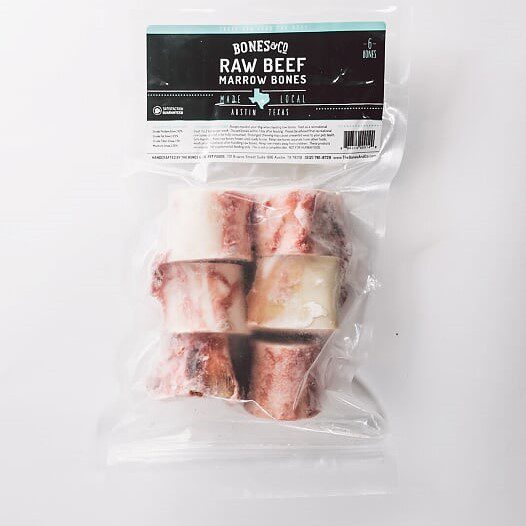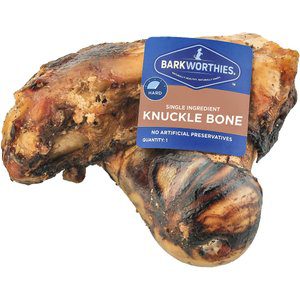Are bones good for your dog?
Giving your dog a bone seems an easy decision, but do you know if bones are good for your dog? And, more importantly, are you picking the right one?
Let’s start with chewing. Chewing has very important benefits for your dog: it mentally stimulates them, and reduces anxiety (linked to high blood pressure and heart disease). They also stimulates the production of saliva enzymes, which prevent plaque buildup.
They also get minerals (such as calcium) and nutrients while at the same time releasing dopamine, making them feel happy.
If the health benefits outweigh the risks of feeding your dog bones, many experts disagree with this issue. Ultimately, the choice is yours as the parent of your dog.
We always recommend having a chat with your veterinarian before giving your dog any new treats or toys and always supervising them , until you are sure they are under no risk of harm.
Raw or cooked?
Most raw bones are good for dogs. Raw chicken, turkey, lamb, or beef bones are soft enough to chew, eat, and digest.
Raw bones are also a good source of calcium, phosphorus, and other minerals. They benefit their digestive system, including strengthening the stomach muscles, preventing bloat, fostering healthy bowel movements, and preventing anal gland problems.
In Hungry Tails, we carry frozen Tucker’s, Bones & Co, and Northwest Naturals (based on availability)
Tucker’s are beef, bison, or lamb bones, all sourced in the US and produced in a USDA Human Edible Facility, which means they make human and pet products in the same facility under USDA oversight.
Bones & Co’s beef marrow ones are produced in Austin, Texas, in a human-grade kitchen with human-grade meat. Northwest Naturals’ Beef Bones are grass-fed and sourced in the US too.
All three are antibiotic, hormone, and preservative-free.
We also carry other products like dehydrated turkey and chicken wings. Feed those only to big-size dogs with the jaw strength and patience to crush them before consuming them.
One big downside of raw bones is that they can get messy, so we recommend that you have a designated area for them. Use a towel or mat to keep the bone in it so you won’t end up with raw meat all over your rugs and floors.
Cooked bones
Now, for cooked bones. They are more brittle, so they splinter easily. They are less messy and need less sanitizing and handling precautions than frozen bones.
In Hungry Tails, we carry bison bones from Winnie Lou Bones. They have been slow-roasted at low temperatures, maintaining moisture throughout the process, strengthening the bone, and preventing breakage.
Other bones, like Red Barn’s, are also roasted at low temperatures to strengthen the bone. They advise that their bones can break or splinter based on the dog’s chew level and bone density of the individual pieces. We recommend not let your dog unsupervised with a bone.
One thing we do want to emphasize: avoid home-cooked bones. Bones not cooked properly, are weaker and easy to splinter. A dog that eats cooked bones may suffer from broken teeth, mouth injuries, blockages, constipation, rectal bleeding, or peritonitis. All of them can cause death. So, please, do NOT give your dog leftover bones from your steak, no matter how much they beg.
Cooked chicken bones and pork bones are also a big NO.
How to pick the right size
The risk of choking is a major issue for raw and cooked bones if your dog swallows without thoroughly chewing.
If your dog chews a bone down to the brittle part, splintering becomes a problem, so throw the bone right away. Additionally, a bone chewed down too small or with sharp edges should also be thrown away. If your dog has inappropriate chewing behavior, stop using any treats with bones that can harm them.
You know how your dog eats. If your dog swallows food quickly rather than chewing, a bone may be risky, so try giving the bone to your dog after dinner so that it will chew it slower.
Nutritional and safety concerns
The bones with marrow are high in fat so make sure to adjust your dog’s diet to compensate for the additional calories, and if your dog needs a low-fat diet, avoid them completely.
Do not give bones with marrow to dogs with pancreatitis, as the marrow can cause a flare-up.
Frozen bones must stay in the freezer until 10-15 minutes before feeding. Let them thaw, give it to the dog for 15-20 minutes and put it back in the freezer in a Ziploc bag. Throw them out after three to four days. This reduces the likelihood of contamination.
As with all raw meats, bones can carry salmonella and E.coli. If ingested, your dog can get a severe case of food poisoning, so proper handling is imperative to ensure the bones remain in good condition for your dog.
Ensure that the surface your dog is chewing the bone on is clean and sanitized. Use a towel or mat that can be disinfected after every use with a pet-safe disinfectant or water mixed with vinegar.
When can I start giving bones to my dog?
For healthy puppies, 4 to 6 months old is a good age to start, so their immune system is ready to handle the potential pathogens and bacteria in raw meat. As recommended before, talk to your veterinarian before starting any raw treat.
Some of the bones we carry in Hungry Tails:
- Bones & Co. Raw Frozen Marrow Bones $22.99
- Tucker’s Raw Frozen Bones $ 10.99 -$22.99
- Northwest Naturals Frozen Bones $12.99-$22.99
- Winnie Lou Cooked Marrow Bones $6.99-$16.99
- Barkworthies Knuckle Bones $9.99





